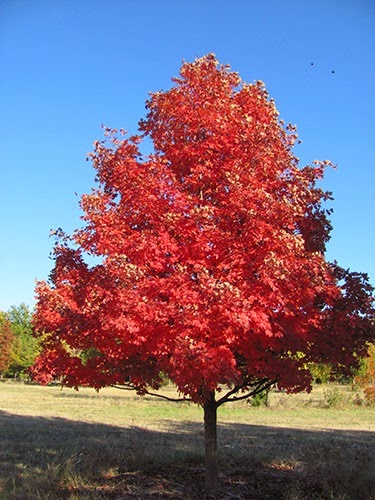Fall is the Perfect Time to Plant a Tree
Cassie Homan, Horticulture Agent
Trees offer shade and beauty in our landscapes as well as reducing utility costs and providing food sources and habitat for wildlife, and the fall season is an excellent time to plant trees. In the spring, soils are cold and may be so wet that there isn’t enough oxygen for adequate root growth. Fall soils are warm and moist which encourages growth. When planted in fall, the tree becomes established well before a spring planted tree and is able to withstand summer stresses. The best time to plant trees in the fall is early September to late October. This is early enough that roots can become established before the ground freezes. However, not all trees produce significant root growth during the fall and are better planted in spring. Trees that grow better when planted in the spring include birch, redbud, magnolia, tulip poplar, willow oak, black oak, willows, and dogwood.
 There are many trees that are adaptable to North Central Kansas. If you are looking for a small tree around 15 to 20 feet we recommend Amur or Tatarian Maple, these trees exhibit beautiful fall color. If you want something a little larger look at European Hornbeam or Golden Raintree, these trees can grow to a height of 40 feet tall. They can handle the drought conditions of Kansas well. If you need a large shade tree, try a Japanese Pagoda, American, or Littleleaf Linden. At maturity they are 50 to 60 feet tall and survive in a wide soil pH range.
There are many trees that are adaptable to North Central Kansas. If you are looking for a small tree around 15 to 20 feet we recommend Amur or Tatarian Maple, these trees exhibit beautiful fall color. If you want something a little larger look at European Hornbeam or Golden Raintree, these trees can grow to a height of 40 feet tall. They can handle the drought conditions of Kansas well. If you need a large shade tree, try a Japanese Pagoda, American, or Littleleaf Linden. At maturity they are 50 to 60 feet tall and survive in a wide soil pH range.
Fall-planted trees require some special care. Remember, that roots are actively growing even though the top is dormant. Make sure the soil stays moist but not soggy. This may require watering not only in the fall but also during the winter months if we experience warm spells that dry the soil. Here are some simple steps to planting a tree;
 Following these steps will ensure your new tree is off to a good start. Remember that a little extra work now will encourage a strong healthy tree for years to come.
Following these steps will ensure your new tree is off to a good start. Remember that a little extra work now will encourage a strong healthy tree for years to come.
If you would like more details about planting trees in your landscape contact Cassie Homan, Post Rock District Horticulture Agent, at (785)738-3597 or by email at choman@ksu.edu
Trees offer shade and beauty in our landscapes as well as reducing utility costs and providing food sources and habitat for wildlife, and the fall season is an excellent time to plant trees. In the spring, soils are cold and may be so wet that there isn’t enough oxygen for adequate root growth. Fall soils are warm and moist which encourages growth. When planted in fall, the tree becomes established well before a spring planted tree and is able to withstand summer stresses. The best time to plant trees in the fall is early September to late October. This is early enough that roots can become established before the ground freezes. However, not all trees produce significant root growth during the fall and are better planted in spring. Trees that grow better when planted in the spring include birch, redbud, magnolia, tulip poplar, willow oak, black oak, willows, and dogwood.
 There are many trees that are adaptable to North Central Kansas. If you are looking for a small tree around 15 to 20 feet we recommend Amur or Tatarian Maple, these trees exhibit beautiful fall color. If you want something a little larger look at European Hornbeam or Golden Raintree, these trees can grow to a height of 40 feet tall. They can handle the drought conditions of Kansas well. If you need a large shade tree, try a Japanese Pagoda, American, or Littleleaf Linden. At maturity they are 50 to 60 feet tall and survive in a wide soil pH range.
There are many trees that are adaptable to North Central Kansas. If you are looking for a small tree around 15 to 20 feet we recommend Amur or Tatarian Maple, these trees exhibit beautiful fall color. If you want something a little larger look at European Hornbeam or Golden Raintree, these trees can grow to a height of 40 feet tall. They can handle the drought conditions of Kansas well. If you need a large shade tree, try a Japanese Pagoda, American, or Littleleaf Linden. At maturity they are 50 to 60 feet tall and survive in a wide soil pH range.Fall-planted trees require some special care. Remember, that roots are actively growing even though the top is dormant. Make sure the soil stays moist but not soggy. This may require watering not only in the fall but also during the winter months if we experience warm spells that dry the soil. Here are some simple steps to planting a tree;
- Select the right tree for the site. To avoid serious problems, choose trees that are adapted to your location. It is important to plant a diverse range of trees. Planting a variety of trees in any particular area will make a big difference if one species is especially vulnerable to a pest or disease, as is currently the case with ash trees in Kansas and other states. Also consider whether the tree produces nuisance fruit or if there are disease-resistant varieties available. You may want to take a soil test to determine the pH of your site.
- Dig a proper hole. Make the hole deep enough so that the root flare is slightly above or even with the ground. The width of the planting hole is very important. It should be three times the width of the root ball.
- Backfill the hole with the same soil that was removed. Amendments such as peat moss likely do more harm than good. Make sure the soil that goes back is loosened - no clods or clumps. Add water as you fill to ensure good root to soil contact. There is no need to fertilize at planting.
- Don't cut back the branches of a tree after planting except those that are rubbing or damaged. The leaf buds release a hormone that encourages root growth. If the tree is cut back, the reduced number of leaf buds results in less hormone released and therefore fewer roots being formed.
- Mulch around the tree, leaving an inch free around the base of the trunk. A moist environment around the trunk encourages harmful insects and disease. Mulch should be 2 to 4 inches deep and cover an area two the three times the diameter of the root ball. Mulching reduces competition from other plants, conserves moisture and keeps soil temperature closer to what the plants' roots prefer. Watering practices will differ based on soil type. In general, a good soaking every 7 to 12 days is sufficient.
 Following these steps will ensure your new tree is off to a good start. Remember that a little extra work now will encourage a strong healthy tree for years to come.
Following these steps will ensure your new tree is off to a good start. Remember that a little extra work now will encourage a strong healthy tree for years to come.If you would like more details about planting trees in your landscape contact Cassie Homan, Post Rock District Horticulture Agent, at (785)738-3597 or by email at choman@ksu.edu








